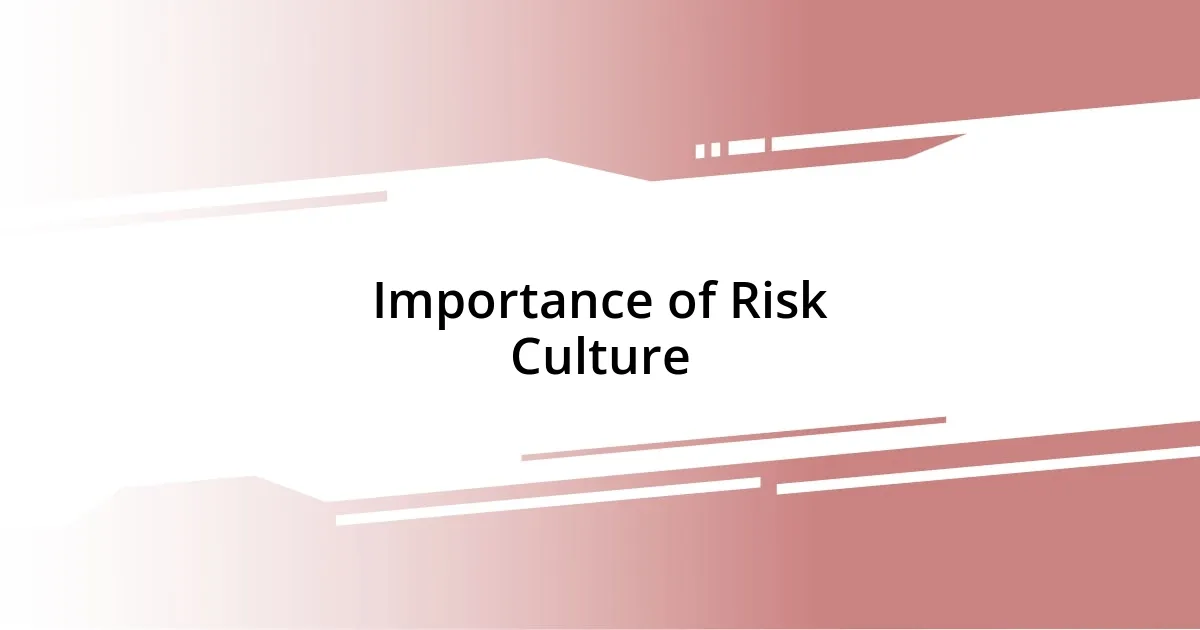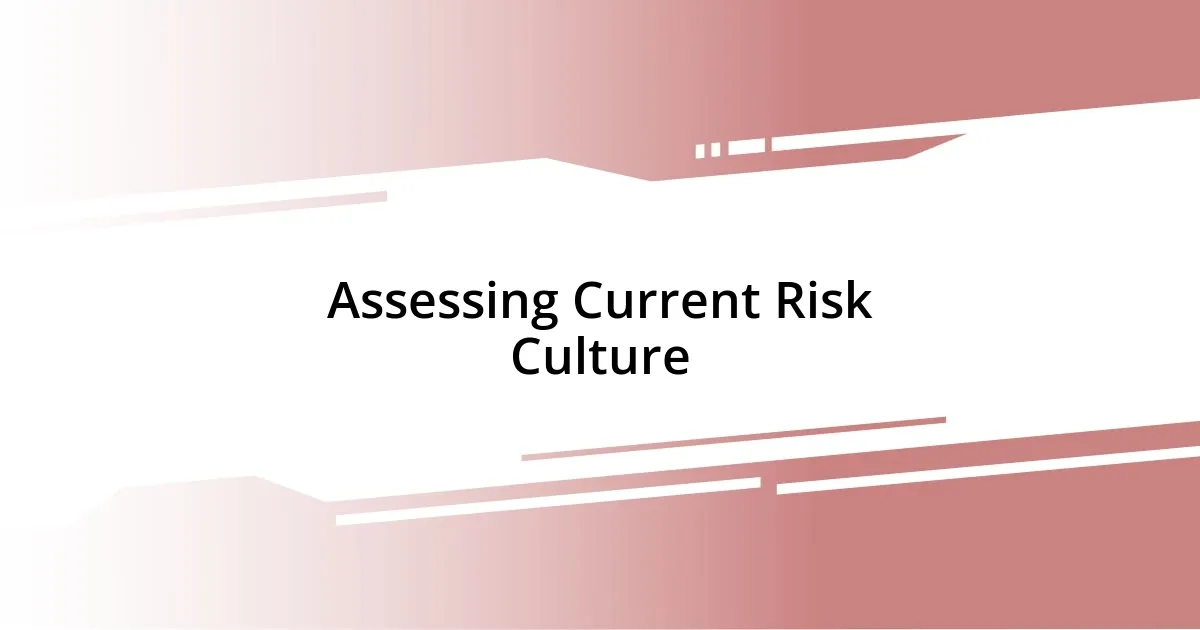Key takeaways:
- Changing risk culture involves reshaping mindsets and behaviors, focusing on openness and shared responsibility.
- A strong risk culture enhances resilience, improves decision-making, and fosters innovation through collective ownership of risks.
- Key elements for a robust risk culture include leadership commitment, open communication, shared responsibility, and continuous training.
- Sustaining a healthy risk culture requires ongoing engagement, regular check-ins, and celebrating small victories to maintain momentum.

Understanding Risk Culture Change
Risk culture change is about shifting the mindset within an organization regarding how risks are perceived and managed. I remember a time in my career when a company faced a significant compliance issue; the atmosphere felt charged with tension. This incident propelled me to ask, “How could we have approached risk differently?”
In understanding risk culture change, it’s crucial to recognize that it’s more than just policies—it’s about people and their behaviors. I’ve seen firsthand how a simple act of open communication can break down barriers and create a more transparent environment. When everyone feels comfortable voicing concerns, it fosters a culture where risk is not something to fear, but rather a shared responsibility.
Moreover, the journey toward changing risk culture can be daunting and emotional. There were moments in my experience when I felt frustrated, as old habits die hard. Yet, each small win reinforced the belief that cultivating a positive risk culture is both possible and rewarding. How do we begin to embrace this change? By committing to continuous learning and encouraging a mindset of growth.

Importance of Risk Culture
The importance of risk culture cannot be overstated. I’ve observed that organizations with a robust risk culture are far more resilient in the face of challenges. When individuals in a workplace take collective ownership of risk management, it not only mitigates potential losses but also enhances overall decision-making. I recall a project where every team member contributed to identifying risks upfront; this preemptive approach not only saved us time but also bolstered trust among colleagues.
Gradually cultivating a positive risk culture is equally essential. Reflecting on my past experiences, I’ve seen that leaders who prioritize open dialogue and encourage feedback create a safe space for discussing risks. This shift fosters innovation, as employees feel empowered to propose solutions without fear of repercussions. I remember a brainstorming session where we tackled a significant operational risk, and the diverse ideas generated truly illustrated how a supportive environment can lead to unforeseen successes.
In addition, risk culture shapes an organization’s identity. It extends beyond immediate outcomes, influencing how teams behave under pressure. From my perspective, organizations that embrace a proactive risk culture are not just reacting to events—they are anticipating them. In a past role, I witnessed a crisis unfold that could have been disastrous. However, due to our cultivated risk culture, we redirected our strategy swiftly and effectively. This experience taught me that the value of risk culture lies in its ability to transform uncertainties into opportunities for growth.
| Aspect | Organizations with Strong Risk Culture |
|---|---|
| Decision-Making | Informed and collaborative |
| Employee Engagement | Higher trust and open communication |
| Innovation | Encouraged through a safe environment |
| Crisis Management | Proactive anticipation of risks |

Key Elements of Risk Culture
Understanding risk culture goes beyond just recognizing its components; it’s an exploration of attitudes, behaviors, and shared values within an organization. I remember a time when working with a team rigidly adhering to traditional risk management practices. It felt almost suffocating. But once we started valuing diverse perspectives—encouraging everyone to voice their thoughts on potential risks—there was this palpable shift. Suddenly, the atmosphere became dynamic and inclusive, allowing us to redefine what risk meant for us collectively.
Here are some of the key elements that contribute to a strong risk culture:
- Leadership Commitment: Leaders are the role models; their attitudes towards risk influence everyone else.
- Open Communication: Encouraging a dialogue where issues can be raised without fear fosters transparency and trust.
- Training and Awareness: Empowering employees with knowledge about risks and their management is crucial.
- Shared Responsibility: When everyone feels accountable for risk, it transforms the mindset from individual burdens to collective ownership.
- Adaptability: A culture that embraces change can effectively respond to evolving risks and challenges.
When I think about the impact of these elements, I recall a project that initially faced significant pushback due to a perceived lack of support from management. However, when leaders decided to actively engage and demonstrate their commitment, it was as if a weight had been lifted. Trust, typically a slow burn in organizations, ignited quickly, paving the way for a smooth implementation of risk mitigation strategies. It struck me how these core elements can truly dictate the climate for risk awareness and collaboration, transforming any organization into a proactive, resilient entity.

Strategies for Effective Change
One of the most effective strategies for facilitating change in risk culture is fostering strong leadership engagement. I’ve experienced firsthand how leaders who genuinely commit to risk management set a powerful tone throughout the organization. Reflecting on a past initiative, we implemented weekly check-ins where leaders consistently discussed risk topics. This not only increased visibility but also encouraged team members to contribute openly. It made me realize how crucial it is for leaders to walk the talk—instead of just promoting risk awareness, they embodied it.
Another strategy that has proven invaluable is investing in comprehensive training programs. I vividly remember a workshop I attended where we tackled real-life risk scenarios together. It was an eye-opening experience; seeing my colleagues actively engage in discussions about risk made me feel part of a collective mission. By equipping employees with the right tools and knowledge, organizations can instill a sense of shared responsibility and accountability. When team members understand the nuances of risk management, they’re more likely to proactively identify and address potential challenges.
I’ve also found that integrating feedback mechanisms is essential for ongoing development. Creating platforms where employees can voice their observations can transform the risk culture significantly. In a previous role, we launched an anonymous suggestion box that allowed staff to share their thoughts about existing risks without fear of judgment. The insights we gained were invaluable! It opened a dialogue about risk awareness that reshaped our strategies going forward. So, why not consider how these simple yet impactful steps could revolutionize your organization’s approach to risk culture?

Assessing Current Risk Culture
Assessing the current risk culture is like peering into the soul of an organization. I remember sitting in a meeting where we dissected our existing practices; it was enlightening yet unsettling. It became evident that many employees felt their concerns about risk were dismissed, creating an atmosphere of fear rather than trust. The discomfort in that room was palpable—why should anyone feel hesitant to speak up about something as vital as potential risks?
As I reflect on my experiences, one pivotal moment stands out. During a risk assessment workshop, we asked participants to anonymously rate their willingness to report issues. The results were shockingly low. It struck me how essential it is to create an environment where everyone feels their voice matters. If current assessments reveal a lack of openness, it’s crucial to reevaluate communication strategies. How can leaders expect a proactive risk culture if employees don’t feel secure in sharing their insights?
In my opinion, understanding risk culture requires more than questionnaires or audits; it demands a genuine exploration of emotions within teams. There’s a profound difference between merely collecting data and truly listening to your people. A few years back, we conducted focus groups to discuss risk perceptions, and the honesty that surfaced was both heartbreaking and illuminating. It reminded me that assessing risk culture isn’t just a task—it’s an opportunity to foster a deeper connection among colleagues, turning fear into a foundation for courage and shared responsibility.

Measuring Change Impact
Measuring the impact of change is a nuanced journey, one that I’ve navigated several times in my career. I recall a specific instance when we implemented a new risk management framework. To truly gauge its effectiveness, we combined quantitative metrics, like incident reports, with qualitative feedback from team members. This dual approach revealed not only the reduction in risk events but also how empowered employees felt to discuss risks openly—an intangible yet critical element of a robust risk culture.
In my experience, one of the most enlightening ways to measure change impact is through employee engagement surveys. After one major shift in our risk practices, we conducted a survey asking staff about their confidence in reporting risks. The increase in positive responses was staggering! It made me reflect on the phrase, “What gets measured gets managed.” It’s about creating a feedback loop that allows leadership to pinpoint what resonates with the team and what still needs attention.
I often wonder, how do we ensure that the measurements we use truly capture the essence of cultural change? One time, we organized a storytelling session where employees shared their experiences with the new risk protocols. It was genuinely eye-opening—many felt like they had a stake in the change process. This anecdote made it clear that numbers alone don’t tell the whole story; we must also listen to the voices that reflect the real impact of our risk culture evolution.

Sustaining Risk Culture Over Time
Sustaining a healthy risk culture over time is an ongoing commitment that requires continuous engagement and adaptation. I vividly recall a company retreat where we focused on long-term strategies for fostering a positive risk environment. During our discussions, it became clear that maintaining momentum hinges on regular check-ins and celebrating small victories. It’s fascinating how recognizing even the tiniest improvements can invigorate a team and encourage further openness.
In my experience, one of the key aspects of sustainability lies in leadership consistency. I once worked under a manager who genuinely modeled vulnerability—she wasn’t afraid to share her own uncertainties about risk, reminding us that acknowledging our fears is a strength, not a weakness. This openness permeated the team, creating a culture where everyone felt comfortable discussing their own challenges. Have you ever noticed how powerful it can be when leaders set the tone? It’s reassuring to know that authenticity can inspire a collective commitment to risk ownership.
Moreover, I believe that training plays an essential role in keeping the risk culture alive. I remember participating in a series of workshops designed to reinforce our risk principles. Each session was more than just instruction; they were opportunities to bond over shared experiences and insights. It dawned on me that ongoing training should be less about compliance and more about fostering relationships and understanding. Ultimately, by infusing our routines with continuous learning, we empower employees to feel invested and vigilant— and that, to me, is the cornerstone of a resilient risk culture.














